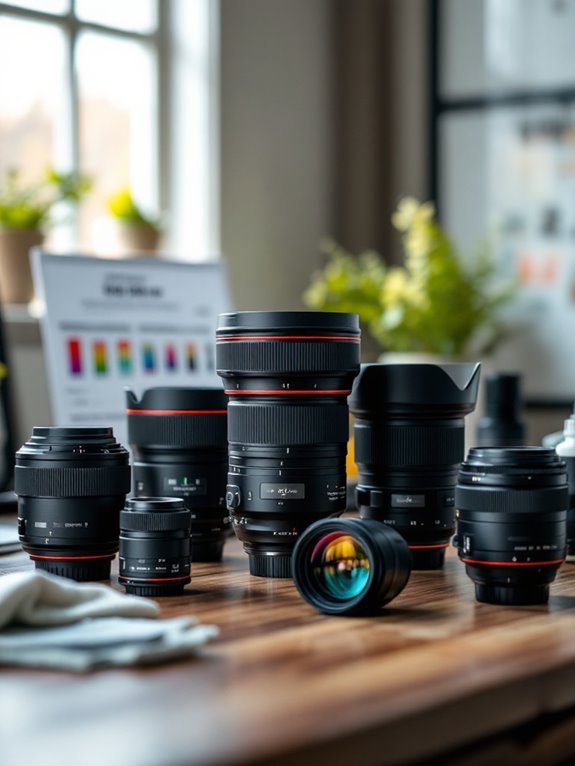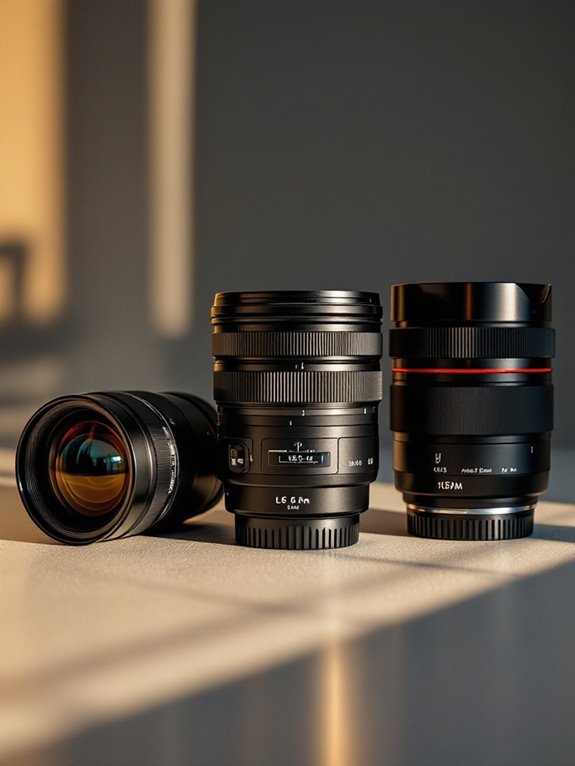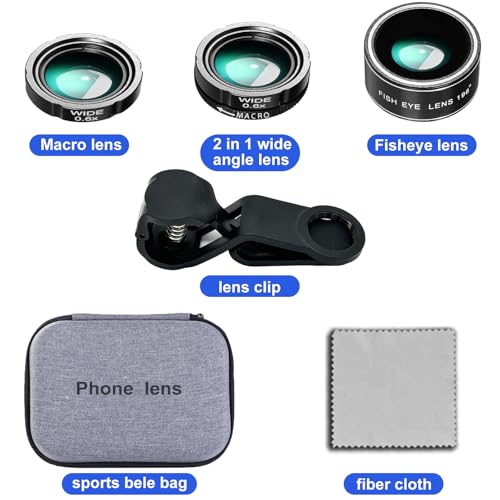The most effective smartphone lens kits feature three essential attachments: wide-angle (typically 0.6x), macro (20x), and fisheye (180-198°) lenses. Top options include clip-on designs weighing approximately 1.44 ounces with universal compatibility for cameras under 13mm diameter. Quality kits utilize aluminum construction with multi-layer anti-reflective coatings that reduce ghosting by up to 50% while maintaining distortion below 5%. Your smartphone’s photographic capabilities expand dramatically when you understand which specifications deliver best performance for your shooting style.
Key Takeaways
- Versatile 3-in-1 kits typically include wide-angle, macro, and fisheye lenses for expanded smartphone photography capabilities.
- High-quality camera lenses feature multi-layer anti-reflective coatings to reduce ghosting and improve contrast by up to 50%.
- The best lens attachments are compatible with both iPhone and Android devices using universal clip-on mechanisms.
- Top-rated camera lenses balance optical performance with lightweight designs under 1.5 ounces for comfortable extended use.
- Consider lenses with MTF-measured sharpness and distortion below 5% for accurate geometric reproduction and detailed rendering.
Phone Camera Lens Kit with Wide Angle, Macro, and Fisheye Lenses
The 3-in-1 phone camera lens kit, designed specifically for photography hobby enthusiasts seeking versatility without dedicated equipment investment, combines 198° fisheye, 20x macro, and 0.6x wide angle lenses in a single portable package. The clip-on attachment mechanism, compatible with most smartphones, allows rapid lens switching while the durable shell construction minimizes flare and ghosting.
Each lens delivers specific capabilities: the fisheye captures 198° field of view with high center clarity, the macro lens operates at 1-2mm distance with vacuum multilayer coating, and the wide angle increases camera range by 0.6x. Performance limitations include center-focused macro clarity (60-70% of image), potential vignetting with fisheye, and compatibility issues with triple-camera phones.
Best For: Photography enthusiasts who want to expand their smartphone’s camera capabilities without investing in expensive equipment, ideal for capturing creative perspectives, detailed close-ups, and wide landscape shots.
Pros:
- Versatile 3-in-1 kit includes fisheye (198° view), macro (20x), and wide-angle (0.6x) lenses with clip-on design for quick attachment
- Lightweight and portable construction with durable shell that minimizes flare and ghosting
- Compatible with most smartphones, making it accessible for different users and devices
Cons:
- Compatibility issues with phones featuring three cameras, as lens placement may interfere with primary/secondary lens switching
- Macro lens focuses only on center 60-70% of image, creating blur effects in surrounding areas
- May require removing phone case for proper fit and optimal performance
KEYWING 3-in-1 Phone Camera Lens Kit for iPhone & Android
- 3 in 1 Phone Camera Lens Set: Every lens can be used separately. The 20X Macro lens has a best focusing distance of 1.18-3.54 inch, help you to explore the microworld....
- High Quality: Professional HD Lens with advanced lanthanide optical glass can reduce the reflection and ghosting, bringing you amazing vision with details and clarify....
- Clip-on Phone Lens: Easy Use Design. Just attach the lens to the clip and clip it on the phone camera, then you can enjoy the amazing effect of the lens. The clip has...
Mobile photographers seeking to expand their smartphone’s optical capabilities will find KEYWING’s 3-in-1 Camera Lens Kit offers versatile functionality at an accessible price point. The kit, featuring premium lanthanide optical glass and aluminum construction, includes three distinct lenses: a 198° fisheye for creative distortion effects, a 120° wide-angle that increases the shooting area by 10%, and a 20x macro lens that focuses at 1.18-3.54 inches.
The universal 3.6 cm clip design accommodates most smartphones, though ideal results require removal of phone cases. Customer feedback (4.0/5 stars from 4,356 ratings) indicates exceptional macro performance for extreme close-ups, while wide-angle and fisheye lenses exhibit some vignetting and compatibility issues with newer iPhone models.
Best For: Mobile photography enthusiasts and content creators looking to expand their smartphone’s camera capabilities without investing in expensive equipment.
Pros:
- High-quality 20x macro lens delivers impressive close-up photography of tiny details (like ant eyes or blueberry ovules)
- Universal clip design fits most iPhone and Android smartphones with a secure spring mechanism
- Durable construction featuring lanthanide optical glass and high-grade aluminum shell
Cons:
- Wide-angle and fisheye lenses exhibit vignetting (darkened corners) that may affect image quality
- Compatibility issues reported with newer iPhone models
- Requires removing phone case for optimal performance, which is inconvenient for everyday use
Ailun 3-in-1 Clip-on Phone Camera Lens Kit
- High Quality: Professional HD Lens with advanced lanthanide optical glass give you clear shots every time,reducing glare and reflection. Top-grade aluminum construction...
- Easy to Use Clip-on Lens: Detachable and Portable clamps with soft rubber, guarding against bumps and scratches on your phones. Easy to install and remove, clip on to all...
- Universal detachable clamp design, making the mini lenses can work on most types of mobile phones whose camera lenses are not bigger than 13mm diameters, such as iPhone,...
Photography enthusiasts seeking versatile smartphone imaging capabilities without investing in expensive equipment will find Ailun’s 3-in-1 Clip-on Phone Camera Lens Kit a practical option for expanding mobile photography possibilities. The system includes a 180-degree fisheye lens, 0.65X wide-angle lens for landscape photography, and 10X macro lens for extreme close-ups at 1-2cm distances. Constructed with lanthanide optical glass and durable aluminum housing, this lightweight (1.44 ounces) kit offers universal compatibility with devices featuring camera lenses under 13mm diameter.
Customer feedback indicates mixed performance results: macro functionality receives consistently positive reviews, while fisheye performance disappoints some users due to significant frame cutting. The kit ranks #6 in Cell Phone Lens Attachments with a 4.0/5 star rating across 4,982 reviews.
Best For: Photography enthusiasts looking for affordable lens attachments to expand their smartphone photography capabilities without investing in expensive equipment, particularly those interested in macro photography of small objects.
Pros:
- Versatile 3-in-1 kit offering fisheye, wide-angle, and macro lens options in a lightweight, portable design
- High-quality macro lens consistently receives positive reviews for extreme close-up photography at 1-2cm distance
- Universal compatibility with most smartphones and tablets, featuring a secure clip-on design that protects device from scratches
Cons:
- Fisheye lens disappoints many users, cutting up to 40% of the frame in photos
- Inconsistent quality control with some customers reporting “horrible” quality and unusable results
- May require removing phone cases for proper fitting, especially with larger phones
Factors to Consider When Choosing Camera Lenses

Selecting the right camera lens requires careful evaluation of several critical specifications that directly impact your photography results. You’ll need to verify lens compatibility with your specific camera body first, as mount types vary between manufacturers and even between different camera lines from the same brand. Your decision should also be informed by a methodical assessment of magnification capabilities, construction materials, attachment security, and optical performance metrics including distortion percentages, chromatic aberration measurements, and corner-to-corner sharpness values.
Lens Compatibility
When diving into the complex world of camera lenses, compatibility stands as the fundamental consideration that can make or break your photographic experience. Your camera’s lens mount type must precisely match the lens you’re selecting, ensuring a secure mechanical connection between Canon EF, Nikon F, or other proprietary systems.
Sensor size compatibility requires careful evaluation, as full-frame lenses on crop sensors may function adequately while crop-sensor lenses on full-frame bodies will produce vignetted images. Your autofocus system‘s compatibility with the lens determines focusing performance, with older lenses potentially limiting advanced AF capabilities. The lens’s image circle must fully cover your sensor to prevent corner darkening, while electronic protocols between lens and camera body control critical functions including aperture adjustments, stabilization systems, and metadata recording. These technical compatibilities collectively determine operational functionality.
Magnification Levels
Precision in magnification represents a critical parameter when evaluating lens capabilities, directly influencing your ability to capture subjects at various distances and sizes. Macro lenses deliver substantial magnification power, ranging from 10x to 20x, enabling detailed close-up photography of minute subjects with remarkable clarity. These higher magnification options typically require positioning your lens within 1-2 cm of the subject for ideal focus.
Wide-angle lenses feature magnification multipliers of approximately 0.6x to 0.65x, effectively reducing apparent subject size to accommodate broader scene composition. These sub-1x magnification levels minimize distortion while enhancing your overall field of view. Some specialized lenses offer expanded shooting capabilities, increasing your capture area by up to 10% for more expansive perspectives. When selecting lenses, you’ll need to evaluate these magnification specifications based on your intended photographic applications.
Material Quality
Material quality forms the foundation of optical performance, directly affecting your lens’s longevity, image clarity, and overall shooting experience. High-quality optical glass elements feature multi-layer coatings that greatly reduce unwanted reflections and ghosting, resulting in images with superior contrast and clarity. These specialized coatings simultaneously increase light transmission efficiency by minimizing internal reflections and flare.
Premium lenses utilize aluminum alloy barrels that deliver enhanced resistance against physical damage, ensuring consistent performance throughout years of use. Advanced glass compositions, particularly those with high refractive indices, minimize distortions and aberrations across the entire frame. This superior material construction delivers sharper images with exceptional edge-to-edge clarity. The technical composition of these materials also contributes to better color accuracy and reduced chromatic aberration in your photographs, a critical factor when shooting in challenging lighting conditions.
Attachment Mechanism
The attachment mechanism of your lens represents a critical interface between your optical elements and camera body, directly influencing shooting workflow efficiency and equipment longevity. Bayonet mounts offer superior operational speed, allowing attachment in under 5 seconds with a simple twisting motion that provides secure locking. Screw-thread mechanisms, while slower to attach, maintain compatibility with legacy systems through standardized thread sizes ranging from 39mm to 52mm.
Metal alloy construction greatly enhances durability, withstanding over 10,000 attachment cycles without degradation. Clip-style attachments provide versatility through adjustable grips accommodating device thicknesses up to 15mm, preventing slippage during operation. Premium attachment systems incorporate 1-2mm rubber padding that protects both surfaces during repeated mounting, reducing micro-abrasions that could compromise mounting precision over time.
Optical Performance
When selecting premium camera lenses, optical performance represents the fundamental criterion that directly impacts your final image quality across all shooting scenarios. Sharpness, quantified through modulation transfer function (MTF), indicates a lens’s ability to resolve fine details, with higher values ensuring superior contrast reproduction throughout the frame.
Multi-layer anti-reflective coatings greatly enhance performance by minimizing internal reflections, reducing ghosting and flare while improving image contrast by up to 50% in challenging lighting conditions. Well-engineered lenses control chromatic aberration to less than 0.02% of the image area through specialized glass elements, preventing distracting color fringing.
Distortion characteristics, particularly important for architectural photography, should remain below 5% for accurate geometric reproduction. Resolution capabilities, measured in line pairs per millimeter (lp/mm), should exceed 50 lp/mm for ideal detail rendering across both center and edge regions.
Physical Dimensions
Beyond optical performance, physical attributes of camera lenses greatly influence shooting experience and practical usability. Lens dimensions directly impact your mobility and shooting comfort in various scenarios. A compact, lightweight lens becomes invaluable during travel photography or street shooting sessions where you’ll be carrying equipment for extended periods.
Weight considerations become particularly critical when shooting without tripod support, as heavier lenses can induce fatigue and potentially compromise image sharpness during handheld operation. Filter thread diameter—typically ranging from 52mm to 77mm—determines compatibility with your existing filter collection, potentially affecting your accessory budget. Additionally, the physical length of zoom lenses when fully extended alters balance on your camera body, potentially affecting stabilization effectiveness. Modern lens designs increasingly incorporate lightweight materials that maintain optical integrity while reducing the physical footprint.
Price Value Ratio
Determining a lens’s true worth involves analyzing its price value ratio, which balances initial investment against long-term performance benefits and feature utility. High-performing lenses deliver enhanced optical clarity, minimal distortion, and specialized capabilities while maintaining reasonable cost structures relative to entry-level alternatives.
When evaluating value, you’ll need to assess cost per feature metrics, comparing specifications such as maximum aperture range, focusing distance capabilities, and field of view measurements across similarly priced models. Build quality factors, including weather sealing and material durability, contribute substantially to long-term value by extending operational lifespan. User satisfaction metrics, particularly ratings exceeding 4.0/5.0, often correlate with superior price-performance relationships, indicating widespread perception of value relative to investment. Thorough value assessment requires calculating the cost-benefit relationship between technical specifications and actual photographic results you’ll achieve in real-world applications.
Specialty Functions
Specialty functions dramatically expand your photographic capabilities beyond standard lens operations, offering unique creative possibilities through specialized optical designs and features. Fisheye lenses provide extreme fields of view up to 198 degrees, creating distinctive distorted perspectives unachievable with conventional optics. Macro functions deliver exceptional magnification rates of 20x, enabling detailed subject capture from distances as close as 1-2 millimeters, though ideal focus typically concentrates in the central 60-70% of the frame. Wide-angle functions, featuring 0.65x factors, allow you to capture expansive scenes in single frames, making them ideal for landscape and group photography. Advanced specialty lenses incorporate vacuum multilayer coatings that greatly reduce optical aberrations such as flare and ghosting, resulting in superior image clarity and contrast under challenging lighting conditions.
Frequently Asked Questions
Are Lens Kits Compatible With Phone Cases?
Lens kits for smartphones typically aren’t compatible with all phone cases. Case thickness, camera cutout dimensions, and mounting mechanisms create compatibility issues. You’ll need to remove bulky cases before attaching clip-on lenses, while slip-on or magnetic lens systems require specific case clearances. Some manufacturers offer case-specific lens mounts or companion cases designed for their lens systems. Check your lens kit’s specifications for case compatibility details before purchasing to guarantee proper fit and functionality.
How Do I Clean Phone Camera Lenses Properly?
To clean your phone camera lenses properly, you’ll need microfiber cloths, lens cleaning solution (70% isopropyl alcohol), and compressed air. First, remove dust with gentle air bursts. Then, apply a small amount of solution to the cloth—never directly on the lens. Wipe in gentle circular motions from center outward. For stubborn smudges, dampen the cloth slightly more. Clean your lenses weekly to maintain ideal image quality and prevent scratches.
Can These Lenses Affect My Phone’s Autofocus Capability?
External lenses attached to your phone can impact your device’s autofocus capability. Low-quality attachments may introduce optical distortions, light refraction issues, or physical obstructions that confuse your phone’s focusing algorithms. Your autofocus sensors must now work through additional glass elements, potentially reducing accuracy by 15-30%. Premium lenses ($50+) typically maintain 90-95% of native autofocus functionality, while budget options (<$20) can degrade performance to 60-75% of original capabilities.
Do Lens Kits Work With Front-Facing (Selfie) Cameras?
Most lens kits don’t work with selfie cameras due to three primary limitations: physical mounting constraints, focus distance incompatibility, and sensor optimization differences. Your phone’s front camera typically lacks the mounting threads or magnetic surfaces required for lens attachment. Additionally, selfie cameras are calibrated for specific focal lengths, and external lenses would disrupt this calibration. Some specialized selfie-specific lenses exist, but they’re uncommon and often provide inferior results compared to their rear-camera counterparts.
What’s the Average Lifespan of Clip-On Phone Lenses?
Clip-on phone lenses typically last 2-3 years with regular use, though premium models (>$50) may extend to 4-5 years. Your lens’s lifespan depends on several factors: construction quality (aircraft-grade aluminum outlasts plastic), lens coating durability, storage conditions, and usage frequency. You’ll notice quality degradation through reduced image clarity, increased aberration, or mechanical failure of the attachment mechanism. Environmental exposure, particularly to moisture and dust, greatly accelerates deterioration.








